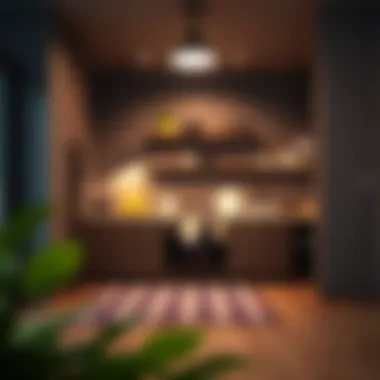Personalized Anti-Fatigue Kitchen Mats for Comfort


Intro
The kitchen is often considered the heart of a home. It’s a space where culinary creativity flows, and memories are made. However, spending long hours on your feet in the kitchen can take its toll, leading to fatigue and discomfort. This is where personalized anti-fatigue kitchen mats come into play, merging functionality with design to enhance the cooking experience.
Gone are the days when kitchen mats were just a plain piece of rubber or fabric. Today, they can be tailored to match your kitchen’s aesthetic, ensuring that comfort doesn't clash with style. Their primary function is to cushion your feet and provide support, reducing strain on your back and joints.
In this article, we will explore various aspects of personalized anti-fatigue kitchen mats, including their benefits, materials, styles, and upkeep. We aim to provide a comprehensive guide that caters to those who value comfort alongside beautiful kitchen decor. Let’s dive deeper into the fabric knowledge and how it affects your choice of mat.
Understanding Anti-Fatigue Kitchen Mats
In the contemporary kitchen, the role of anti-fatigue mats is increasingly recognized. These mats are not just simple floor coverings; they represent a step towards transforming how we approach cooking and food preparation. Notably, when individuals remain on their feet for extended periods, discomfort can arise. It’s at this intersection of need and innovation that anti-fatigue kitchen mats come into play.
Personalized anti-fatigue kitchen mats provide a blend of comfort and style. They are designed not only to improve the ergonomics of the kitchen but to complement the overall aesthetics of the space. Moreover, as kitchens often become the heart of the home, having a comfortable workspace is paramount to enhance the cooking experience. In short, understanding these mats is crucial for anyone looking to enhance their culinary environment, whether it be an amateur cook, a busy parent, or a culinary professional.
Definition and Purpose
Anti-fatigue mats are specially engineered products designed to reduce fatigue caused by prolonged standing. As the name suggests, their primary purpose is to alleviate the physical strain that comes from being on one’s feet for too long. Basically, they provide a cushioned layer between the hard floor and the individual standing upon it. This cushioning effect can lead to reduced discomfort in the feet, legs, and back.
One can think of them as a supportive friend in the kitchen, allowing for extended cooking sessions without the usual aches and pains. They come in various styles and sizes, catering to different preferences and needs, hence the push toward personalization. They do more than just protect the flooring; they become an integral part of the cooking experience.
How Anti-Fatigue Mats Work
The science behind anti-fatigue mats is rather fascinating, revealing how simple changes can lead to significant enhancements in comfort. These mats typically employ materials like rubber, foam, or gel to create a supportive base. By providing a slight give underfoot, anti-fatigue mats encourage subtle movements while standing. This movement activates muscles that might otherwise remain stagnant, promoting better circulation.
When you stand on a conventional surface, such as tile or wood, your body feels the full force of gravity, leading to fatigue over time. Anti-fatigue mats counter this by creating an environment that reduces pressure points and encourages micro-movements, almost like a gentle bounce.
In essence, these mats work to energize rather than exhaust, making them a wise investment for anyone who spends significant time in the kitchen. This understanding of how they function enhances appreciation for their benefits and highlights the importance of choosing the right type for individual needs.
Benefits of Personalized Anti-Fatigue Kitchen Mats
In today’s culinary world, the comfort of the chef is paramount. When standing for prolonged periods, many enthusiasts or professionals alike can feel the strain on their bodies. Personalized anti-fatigue kitchen mats offer a host of benefits that are the unsung heroes of culinary spaces. Not merely a stylish addition, these mats serve crucial functions that significantly enhance both comfort and the overall kitchen environment.
Reducing Discomfort
When it comes to spending long hours in the kitchen, discomfort is often an unwelcome companion. Anti-fatigue mats are designed precisely for this reason. The cushioning they provide helps to absorb the impact of standing, distributing weight evenly across the feet.
These mats often have a soft, yielding surface that allows for a more relaxed standing posture. Without proper support, standing on hard floors can lead to fatigue, pain in the back and joints, and even varicose veins over time. A quality anti-fatigue mat tackles these issues head-on by reducing pressure on the feet and legs.
- Enhanced Comfort: With a soft surface, these mats decrease strain on joints and allow chefs to focus on their tasks without the distraction of discomfort.
- Less Fatigue: By encouraging subtle movements, they promote blood flow and reduce tiredness, allowing for longer, more efficient cooking sessions.
Promoting Better Posture
Good posture plays a pivotal role in overall health and ergonomics, particularly when standing for long periods. Anti-fatigue mats encourage an upright position since they slightly promote movement.


Standing on a firm surface can lead to slouching or awkward angles, which strains the spine and surrounding muscles. In contrast, a quality mat fosters an upright stance. When folks stand correctly, less pressure is put on the spine and surrounding muscles.
- Supportive Design: Many anti-fatigue mats are contoured to subtly encourage better posture. Their design helps to activate muscles that support the lower back, thus mitigating fatigue.
- Holistic Well-being: A significant benefit is the reduction in long-term musculoskeletal issues. Good posture can decrease the risk of developing chronic conditions related to improper body mechanics.
Enhancing Kitchen Aesthetics
Beyond comfort and support, personalized anti-fatigue mats can transform the visual appeal of a kitchen. With various designs, colors, and patterns available, these mats can fit seamlessly into different kitchen decors.
Customizing mats allows individuals to select styles that resonate with their personality and the overall vibe of their cooking space. From modern minimalistic patterns to vibrant prints, the choice is extensive.
- Personal Style: A personalized mat can reflect individual taste, adding a touch of flair that complements kitchen materials and colors. Imagine a sleek black mat that contrasts perfectly against white cabinets or a funky pattern that livens up a neutral kitchen.
- Cohesive Look: With so many options available, it’s possible to create a cohesive design that enhances not just the functionality but also the attractiveness of the kitchen environment.
In summary, the benefits of personalized anti-fatigue kitchen mats extend beyond mere comfort; they play an essential role in reducing discomfort, promoting better posture, and enhancing the aesthetic of the kitchen space. Embracing such a mat is an informed decision that not only elevates comfort levels but also enriches the overall cooking experience.
Remember, investing in your kitchen environment is investing in yourself.
Material Choices for Kitchen Mats
When it comes to creating a comfortable and efficient cooking environment, the choice of materials for kitchen mats plays a crucial role. Kitchen mats are not just decorative items; they fulfill an essential purpose by providing a cushioned surface that reduces fatigue during long periods of standing. Different materials offer varying degrees of support, durability, and aesthetic appeal. Understanding these material choices will help you select a mat that not only enhances comfort but also aligns with your kitchen style.
Common Materials Used
Several materials are commonly used in the manufacturing of kitchen mats, and each brings its own set of features to the table:
- Rubber: Known for its slip-resistant properties, rubber mats offer excellent cushioning and support. They are both durable and easy to clean, making them a popular choice among commercial kitchens.
- Foam: Soft foam mats provide a comfortable surface that can reduce stress on your feet and joints. They are lightweight and often come in a variety of colors and patterns, appealing to those looking to add a personal touch to their space.
- Vinyl: This material is also favored for its durability and ease of maintenance. Vinyl mats can mimic the look of hardwood or tile, which can complement various kitchen aesthetics.
- Gel: Gel mats are designed to provide better cushioning than standard foam mats. They offer a soft, spongy surface that feels luxurious underfoot, ideal for extended periods of standing while cooking or preparing meals.
Each of these materials can provide different levels of comfort and support, depending on an individual's needs and preferences.
Durability Considerations
Selecting an anti-fatigue mat based on durability is essential for ensuring long-term performance. The lifespan of a kitchen mat often depends on the material used and the frequency of use. For example:
- A rubber mat may withstand heavy traffic and resist wear over time, while being less likely to tear or develop cracks.
- Foam mats may compress over time, losing their cushioning effect, especially if they’re made from lower-density foam.
- Vinyl is resistant to moisture and stains but could wear down at the edges if not cared for properly.
- Gel mats offer great comfort but may be prone to punctures and tears if not used carefully.
Hence, it's essential to consider where the mat will be used. Mats placed in high-traffic areas of the kitchen should be made from tougher materials that can endure constant foot traffic without deteriorating quickly.
Eco-Friendly Options
As more people become conscious of their environmental footprint, eco-friendly kitchen mats are gaining popularity. These mats utilize sustainable materials and processes to minimize their impact on the planet. Some notable eco-friendly options include:
- Natural rubber mats, sourced from rubber trees, provide a renewable alternative to synthetic materials. They are biodegradable and often free from harmful chemicals.
- Cork mats, which are both natural and renewable, offer antimicrobial properties, making them perfect for kitchens where cleanliness is paramount.
- Recycled materials, like recycled vinyl or plastics, are increasingly being used in the production of kitchen mats, giving second life to materials that would otherwise contribute to landfill waste.
Design Aspects of Personalized Kitchen Mats


In today’s bustling kitchens, the synergy of comfort and style is pivotal. Personalized anti-fatigue kitchen mats not only diminish discomfort from standing for extended periods but also act as a canvas for one's individual flair. The design aspects of these mats are crucial, as they intersect functionality with personal expression. A well-chosen mat can uplift the kitchen’s aura while delivering the ergonomic benefits it promises.
Customization Opportunities
When discussing customization opportunities, one realizes how versatile kitchen mats can truly be. Beyond mere color and pattern, options like monograms, graphics, or themed designs allow homeowners to tailor their mats to feature family names, graphics that represent hobbies, or seasonal themes. Imagine stepping onto a mat that features a cheeky culinary quote or a vibrant depiction of fresh vegetables. It's not just about comfort but about creating a space that resonates with your personality.
Moreover, personalization could extend to the size and shape of the mat. Whether you need a runner for a narrow galley kitchen or a large mat for a spacious cookery, customization caters to those specific needs. In a world where mass production is the norm, having a mat that says “this is me” is a unique touch.
Incorporating Personal Style
Incorporating personal style into kitchen mat design is an art form by itself. A mat can serve as a statement piece or blend seamlessly into existing decor. Whether your kitchen leans toward a modern minimalist aesthetic with sleek lines and neutral palettes or a rustic farmhouse vibe with warm tones and textured finishes, there's a mat that can complement it perfectly. For instance, a bold geometric print can inject contemporary flair, while a vintage pattern can resonate with traditional tastes.
The right mat not only enhances visual appeal but also invites comfort. As one stands to chop vegetables or whisk ingredients, the vivid or calming visuals from the mat surface can make tasks feel less of a chore and more of a creative venture. Each time one steps into the kitchen, it becomes an experience shaped by not just functionality but also personal taste.
Trends in Kitchen Mat Designs
Keeping in tune with the trends in kitchen mat designs, it's evident that home aesthetics evolve along with lifestyle choices. Say goodbye to the bland, utilitarian mats of yesteryear. Nowadays, kitchen mats are crafted in a multitude of designs that align with current home decor philosophies. For instance, watercolor themes or botanical prints resonate with those wanting to bring a touch of nature indoors, illustrating a trend towards biophilic design.
Additionally, there’s a surge in eco-friendly materials which dovetail beautifully with aesthetic demands. Brands have begun embracing biodegradable or recycled materials, allowing consumers to make style choices that are also considerate of the planet. Such trends not only reflect a societal shift towards sustainability but also emphasize the dual role of kitchen mats as both decorative and functional elements.
Selecting the Right Anti-Fatigue Mat
When it comes to your culinary sanctuary, comfort should never take a backseat. Selecting the right anti-fatigue mat may just be one of the best investments you can make, especially if you find yourself standing for extended periods of time. Not only do these mats reduce stress on your feet, but they also play a significant role in contributing to your overall well-being while cooking. With so many factors at play, it’s crucial to navigate the nuances that come with choosing the optimal mat for your space.
Factors to Consider
When evaluating anti-fatigue mats, consider multiple elements that can impact both functionality and comfort. Below are some of the key factors you should keep in mind:
- Material Quality: The included material greatly dictates comfort and durability. Foam is often the go-to option due to its cushiony feel. However, rubber alternatives can provide excellent grip and weather resistance, making them suitable for heavy-duty kitchens.
- Thickness and Density: Mats come in various thicknesses, typically ranging from half an inch to one inch. Thicker mats provide additional cushioning, but too much density can disrupt your balance while standing.
- Design and Style: Personal preferences regarding color patterns and styles should not be overlooked. A mat that aligns with your kitchen’s aesthetic will not only enhance its visual appeal but also reflect your taste.
- Price Range: Think about your budget. Investing in a quality anti-fatigue mat may seem steeper initially, but weighing the cost against comfort and longevity can highlight its value.
Evaluating Size and Shape
Selecting the correct size and shape of your anti-fatigue mat is just as critical as material choice. The fit of the mat will directly affect your comfort and safety while working in the kitchen. Consider the following elements:
- Kitchen Layout: Examine your kitchen’s layout and determine the areas where you stand most often while working. The mat should ideally cover these regions to maximize comfort.
- Training the Eye: Take measurements of your workspace. Whether you’re aiming for a rectangular mat that fits snugly beside the stove or a more elongated oval shape that extends beneath the sink, ensure the size complements your actual usage.
- Placement Strategy: Think about where you do most of your culinary tasks. A larger mat might be appropriate for an island where you chop veggies, while a smaller option could suffice near the stove.
Choosing wisely can significantly enrich your cooking experience, transforming a sluggish kitchen chore into a delightful culinary adventure. Thus, prioritizing the right elements creates a workspace where creativity can flourish.
Maintenance of Anti-Fatigue Kitchen Mats
Taking care of your anti-fatigue kitchen mats is essential. It’s a bit like tending a garden; if you don’t give it the attention it needs, it won’t flourish, and neither will your comfort while cooking. Proper maintenance not only extends the life of these mats but also ensures they function as they should, helping reduce fatigue during those marathon cooking sessions.
Cleaning and maintaining these mats effectively can prevent deterioration. Dirt, grease, and spills can quickly turn your comfy spot into a health hazard, harboring bacteria and mold. Regular upkeep helps avoid this situation and keeps your kitchen looking sharp.
Cleaning Guidelines


Cleaning anti-fatigue mats doesn’t have to be rocket science. Here are some practical tips:
- Regular Sweeping and Vacuuming: Removing crumbs and debris keeps your mat in good shape. A simple vacuum or a quick sweep daily can make all the difference.
- Spot Cleaning: For stains or spills, use a damp cloth with mild soap. It’s like giving your mat a quick freshen-up. This method can help remove stubborn stains without damaging the material. Be sure to rinse thoroughly to avoid soap residue.
- Deep Cleaning: Depending on the mat’s material, it might require more thorough cleaning every few weeks or so. Use a floor scrubber or a steam cleaner suitable for the material of your mat. Avoid harsh chemicals, especially if you opted for an eco-friendly variant.
When it comes to drying, air-drying is your best bet. Letting mats dry outside rather than using heat sources will prevent warping.
Longevity Tips
Keeping your anti-fatigue mats looking good and functioning well for years requires some foresight. Here’s how to ensure their longevity:
- Avoid Direct Sunlight: If your kitchen has a sunny spot, try to keep the mats out of direct sunlight. Too much sun exposure can fade colors and weaken materials over time. It’s about giving them a comfy spot, just like you!
- Rotate Mats Regularly: If you have multiple mats in different areas, rotate them often. It’s akin to changing your shoes; it allows each mat some time off and helps distribute wear and tear more evenly.
- Inspect Regularly: Give your mats a good once-over every so often. Look for any signs of wear, such as fraying edges or tears. Addressing small issues now can prevent bigger ones down the line. Taking that proactive approach can save you a lot of hassle later.
Remember, a little bit of care goes a long way. Personalizing and maintaining your anti-fatigue mats will not only improve your cooking experience but also enhance the overall aesthetic of your kitchen.
User Experiences and Testimonials
Understanding user experiences and testimonials is a cornerstone in grasping the real-world impact of personalized anti-fatigue kitchen mats. It’s not just about the specs; it’s about how these mats change the everyday lives of those who use them in their culinary spaces. Personal accounts reveal the comfort and ease these mats bring, which can resonate more than any marketing spiel.
Real-world Applications
Let's take a look at some user scenarios that illustrate the necessity of these anti-fatigue mats. Home cooks, professional chefs, and even enthusiastic hobbyists often find themselves standing in one place for long periods. For instance, a mother of three shared that cooking dinner used to be a backbreaking ordeal. With a personalized mat, her experience transformed completely. The cushioned support minimized fatigue, allowing her to comfortably chop, stir, and bake without the sharp pangs in her lower back that once accompanied her culinary efforts.
Furthermore, a small café owner noted the significant improvement in her employees' morale after introducing anti-fatigue mats behind the counter. Staff reported less discomfort during busy shifts, improving their efficiency and customer interactions. This real-world testimony highlights the practical benefits while subtly showcasing how these mats contribute to a healthier work environment.
Impact on Daily Cooking Routines
User experiences demonstrate a notable shift in cooking routines post-mat acquisition. One avid baker mentioned how her all-day flour-dusted marathon baking sessions now feel less grueling. Before, her legs would feel like overcooked spaghetti; now, she can stand for hours focusing on her craft instead of the discomfort.
Here are a few takeaways on how these mats can influence daily routines:
- Comfort Leads to More Creativity: Without the distraction of physical discomfort, users can focus their energy on culinary creativity rather than surviving the aches that come from standing.
- Encouragement to Cook More: With reduced fatigue, people are more likely to embrace cooking, experimenting with new recipes and exploring culinary skills previously found daunting.
- Enhanced Social Interaction: Comfortable cooking spaces encourage entertaining friends and family more often. The kitchen becomes a gathering hub instead of a chore-laden battlefield.
To sum it up, these user experiences and testimonials provide a compelling narrative of how personalized anti-fatigue kitchen mats positively impact comfort and efficiency in culinary environments. They highlight so much more than the physical benefits; they reflect a shift towards a more enjoyable, healthier cooking experience.
Culmination
In wrapping up our exploration of personalized anti-fatigue kitchen mats, it's clear that these mats embody both comfort and functionality. They are not just an accessory for the kitchen; they play a crucial role in enhancing one’s culinary experience. The benefits of these mats extend beyond mere aesthetics or a fancy design. They promise a tangible reduction in discomfort during those long cooking sessions, promoting healthier posture and overall well-being.
When choosing a personalized anti-fatigue kitchen mat, it’s essential to remember the various factors at play. Materials, thickness, and durability are pivotal in selecting a mat that meets both your practical needs and design preferences. This article has emphasized how customization can bridge the gap between practicality and personal taste, ensuring that your kitchen not only serves as a workspace but also as a reflection of your style.
Overall, the integration of anti-fatigue mats into culinary spaces can significantly improve one's cooking experience. Thus, understanding their features and benefits can lead to more informed choices when enhancing your kitchen environment.
Recap of Key Points
- Alleviation of Discomfort: Personalized anti-fatigue mats reduce strain on the body during prolonged standing, making kitchen tasks more enjoyable.
- Posture Improvement: They promote better alignment and posture while cooking, which can have long-term health benefits.
- Aesthetic Enhancement: With customization options, these mats can complement the existing decor, elevating the overall kitchen ambiance.
- Material Variety: Understanding the different materials can help in making a choice that is both durable and suitable for personal needs.
- Maintenance Awareness: Proper care can extend the life of the mats, ensuring prolonged comfort and usability.
Encouragement for Informed Choices
In light of the various features of personalized anti-fatigue kitchen mats, it's crucial for consumers to approach the selection process with mindfulness. Don’t just leap at the first design that catches your eye; consider how it fits into your lifestyle and cooking habits. Take the time to research materials and sizes. Links to resources like Wikipedia and Britannica can provide a deeper understanding of ergonomics that informs your decision.
Moreover, don’t hesitate to explore user reviews and testimonials. Hearing about real-world applications can often shed light on what works best for different needs. Armed with this knowledge, you can choose a kitchen mat that not only serves its purpose but also transforms your cooking space into a comfortable and inviting environment.















